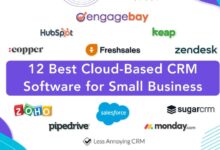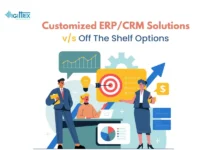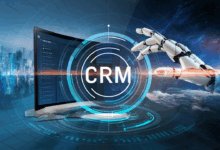CRM System Pricing: Finding The Right Fit For Your Business
CRM system pricing is a crucial aspect of any business strategy, impacting operations and profitability. Understanding the intricacies of pricing models and factors affecting costs can help businesses make informed decisions. Let’s delve into the world of CRM system pricing to uncover key insights and considerations.
Discuss the Key Features of Email Marketing Software
Email marketing software plays a crucial role in helping businesses connect with their audience and drive engagement. Here are some key features that email marketing software should have:
Essential Features of Email Marketing Software
- 1. Contact Management: Efficiently manage your contact list and segment them based on various criteria.
- 2. Email Templates: Create visually appealing and responsive email templates for your campaigns.
- 3. Automation: Set up automated email campaigns based on triggers like user actions or time intervals.
- 4. Analytics: Track the performance of your email campaigns with detailed analytics and reporting.
Some popular email marketing software tools in the market include Mailchimp, Constant Contact, and Sendinblue. These tools offer a range of features to streamline email marketing efforts and drive better results.
Automation and segmentation features in email marketing software can significantly enhance email campaigns. By automating certain tasks and segmenting your audience based on their behavior or interests, you can deliver more personalized and targeted content, leading to higher engagement and conversions.
Compare Customer Support Software Solutions
When it comes to customer support software solutions, it’s essential to consider pricing, features, and customer reviews to make an informed decision. Here is a comparison table outlining the key differences between some of the top customer support software solutions:
| Software | Pricing | Features | Customer Reviews | Integration |
|---|---|---|---|---|
| Zendesk | $$ | Live chat, ticketing system, knowledge base | Positive | Integrates with various tools |
| Freshdesk | $ | Multi-channel support, automation, reporting | Good | Offers multiple integrations |
Integration capabilities with other tools and platforms are crucial for seamless customer support operations. Look for software solutions that offer easy integration with your existing systems to enhance overall efficiency.
Analyze Social Media Management Tools
When analyzing social media management tools, it’s essential to consider pricing structures and features offered. Leading social media management tools like Hootsuite, Buffer, and Sprout Social provide a range of features to help businesses manage their social media presence effectively.
Analytics and reporting functionalities are key components of social media management tools. By tracking key metrics like engagement, reach, and conversions, businesses can gain valuable insights into the performance of their social media campaigns and make data-driven decisions to optimize their strategy.
Explore eCommerce Platform Options
Comparing pricing models of popular eCommerce platforms like Shopify, WooCommerce, and BigCommerce can help businesses choose the right solution for their online store. Each platform offers unique features and scalability options to support businesses of different sizes.
Setting up an online store using an eCommerce platform involves steps like choosing a domain, selecting a theme, adding products, and setting up payment gateways.
Scalability options available with different eCommerce platforms allow businesses to grow and expand their online presence seamlessly. Consider factors like product catalog size, traffic volume, and customization options when selecting an eCommerce platform.
Review Project Management Software for Teams
Project management software is essential for teams of all sizes to collaborate effectively and manage tasks efficiently. Here is a comparison chart of project management software based on collaboration features:
- Asana: Offers task management, project timelines, and team collaboration features.
- Trello: Known for its visual boards, task cards, and customizable workflows.
- Jira: Ideal for software development teams with advanced issue tracking and agile project management capabilities.
Customization options in project management tools allow teams to tailor the software to their specific needs and workflows. Look for software solutions that offer flexibility and customization to optimize team productivity and project success.
Types of CRM System Pricing Models
When it comes to CRM system pricing, there are various models that companies can choose from based on their needs and budget. Understanding the different pricing models is crucial to make an informed decision.
Subscription-based Pricing vs. One-time Licensing Fees
Subscription-based pricing involves paying a recurring fee at regular intervals (monthly, annually) to access the CRM system. On the other hand, one-time licensing fees require a single upfront payment to use the software indefinitely.
- Subscription-based Pricing:
- Advantages:
- Lower initial costs, making it more affordable for small businesses.
- Regular updates and support included in the subscription.
- Disadvantages:
- Higher total cost over time compared to one-time licensing.
- Dependency on continuous payments to maintain access.
- Advantages:
- One-time Licensing Fees:
- Advantages:
- Lower long-term costs for businesses planning to use the CRM system for an extended period.
- No ongoing payments once the license is purchased.
- Disadvantages:
- Higher upfront costs may be a barrier for small businesses.
- Limited support and updates without additional fees.
- Advantages:
Usage-based Pricing for CRM Systems
Usage-based pricing charges customers based on the features they use or the number of users. This model allows companies to pay only for what they use, making it a flexible option.
Usage-based pricing can be cost-effective for businesses with fluctuating needs as they can adjust their usage and costs accordingly.
Tiered Pricing and its Relevance to CRM System Pricing
Tiered pricing offers different packages with varying features and prices, catering to different customer segments based on their requirements and budget. This model allows businesses to choose a plan that aligns with their needs.
Importance of Transparent Pricing Structures in CRM Systems
Having transparent pricing structures in CRM systems is crucial for building trust with customers. Clear pricing helps businesses understand the costs involved and make informed decisions without hidden fees or surprises.
Popular CRM Systems with Flexible Pricing Options
Some popular CRM systems that offer flexible pricing options include Salesforce, HubSpot, Zoho CRM, and Pipedrive. These platforms provide a range of plans to accommodate businesses of all sizes and budgets.
Factors Affecting CRM System Pricing
When it comes to the pricing of CRM systems, there are several factors that can influence the cost. Understanding these key factors can help businesses make informed decisions when selecting a CRM solution.
Key Features Impacting CRM System Pricing
- Customization Options: The level of customization available in a CRM system can greatly impact the pricing. More customizable features often come with a higher price tag.
- Integration Capabilities: CRM systems that offer seamless integration with other software applications tend to be priced higher due to the added convenience and efficiency.
- Data Storage and Security: The amount of data storage provided and the security measures implemented in a CRM system can affect the pricing structure. Enhanced security features may lead to higher costs.
Scalability and User Limits Influence
- Scalability: The ability of a CRM system to scale with your business growth can impact pricing. Systems that can easily accommodate increasing data and users may come at a higher cost.
- User Limits: Some CRM solutions have user-based pricing models where the number of users directly affects the cost. Additional users may incur extra charges.
Vendor Reputation and Customer Support
- Vendor Reputation: Established vendors with a strong reputation in the industry may charge higher prices for their CRM systems due to the perceived value and reliability of their products.
- Customer Support: The quality and availability of customer support services can influence the overall cost of CRM solutions. Systems with dedicated support teams may have higher price points.
Training and Onboarding Services Importance
- Training and Onboarding: CRM systems that offer comprehensive training and onboarding services may come at a premium. However, investing in proper training can lead to better utilization of the system and improved ROI in the long run.
Hidden Costs in CRM System Pricing
When considering the pricing of a CRM system, it’s essential to be aware of the potential hidden costs that may arise during implementation and beyond. These costs can significantly impact the overall investment required for a CRM solution.
Common Hidden Costs
- Customization Fees: Many CRM systems require customization to align with specific business processes. This customization often incurs additional costs from the vendor or third-party consultants.
- Integration Costs: Integrating a CRM system with existing software or databases can be complex and may involve fees for technical expertise and resources.
- Training Expenses: Training employees to effectively use a new CRM system can be costly, especially if extensive training programs are needed.
Examples of Add-On Costs
- Support and Maintenance Fees: Some CRM vendors charge ongoing fees for support, maintenance, and software updates.
- Data Storage Costs: As your database grows, additional storage may be required, leading to increased costs for data storage.
- Additional User Licenses: If your organization expands, you may need to purchase additional user licenses for the CRM system.
Strategies for Budgeting for Hidden Costs
- Conduct a thorough assessment of your organization’s needs and requirements before selecting a CRM system to anticipate potential customization and integration costs.
- Allocate a budget specifically for training to ensure that employees are equipped to utilize the CRM system effectively.
- Consider negotiating a comprehensive pricing package with the vendor that includes support, maintenance, and future upgrades to avoid unexpected costs.
Price Comparison of Popular CRM Systems
When looking at the pricing plans of the top CRM providers like Salesforce, HubSpot, and Zoho, it’s important to consider the features offered at various price points, the value proposition of each system, and any hidden costs that might impact the overall price comparison.
Salesforce
- Basic Plan: $25/user/month
- Professional Plan: $75/user/month
- Enterprise Plan: $150/user/month
- Additional fees for advanced features and customization
HubSpot
- Starter Plan: $45/month
- Professional Plan: $450/month
- Enterprise Plan: $1200/month
- No hidden costs, all features included in pricing
Zoho
- Standard Plan: $14/user/month
- Professional Plan: $23/user/month
- Enterprise Plan: $40/user/month
- Additional fees for add-ons and integrations
Each CRM system offers different features at various price points, with some including additional fees for advanced customization or integrations. HubSpot stands out for including all features in its pricing, while Salesforce and Zoho have additional costs for certain functionalities.
Support Options
- Salesforce: 24/7 customer service, online resources, dedicated account managers
- HubSpot: Online resources, email support, phone support
- Zoho: Online resources, email support, phone support
Scalability
- Salesforce: Scalable for businesses of all sizes, pricing plans can accommodate growing needs
- HubSpot: Designed for small to medium businesses, may require upgrading to Enterprise plan for larger organizations
- Zoho: Scalable for small to large businesses, pricing adjusts based on user count
Customization Options and Pricing
When it comes to CRM system pricing, customization options play a crucial role in determining the overall cost. Customization features can enhance the functionality of a CRM system but may also come with additional costs. It is essential for businesses to carefully consider their customization needs and budget constraints when selecting a CRM solution to ensure they get the best value for their investment.
Impact of Customization on Pricing
- Customization options such as tailored workflows, personalized dashboards, and integration with third-party applications can increase the cost of a CRM system.
- Advanced customization features like API access, bespoke reporting tools, and specialized modules may require additional investment.
Balancing Customization Needs with Budget Constraints
- Businesses should prioritize customization features that align with their specific requirements and goals to avoid unnecessary expenses.
- Finding a balance between customization needs and budget constraints is essential to ensure the ROI of implementing a CRM system.
Comparison of Pricing Tiers and Customization Options
| CRM Provider | Pricing Tiers | Customization Options | Features | Cost |
|---|---|---|---|---|
| Salesforce | Basic, Professional, Enterprise | Customizable reports, workflows | Lead management, forecasting, analytics | Varies |
| HubSpot | Starter, Professional, Enterprise | Customizable email templates, pipelines | Marketing automation, live chat, social media tools | Varies |
A scenario where a company opted for extensive customization, leading to a significant increase in CRM implementation costs: Company XYZ decided to integrate their CRM system with multiple third-party applications, requiring complex API configurations and custom-built modules. As a result, their initial CRM implementation cost doubled, exceeding their budget projections.
Negotiating CRM System Pricing
When it comes to negotiating CRM system pricing, it’s essential to approach the process strategically and with a clear understanding of what you need. Here are some key strategies to help you secure a favorable deal with vendors:
Importance of Understanding Pricing Structure and Key Negotiation Points
- Before entering into pricing discussions, make sure you thoroughly understand the vendor’s pricing structure and key negotiation points. This will allow you to identify areas where you may have leverage and where there may be room for negotiation.
- Being knowledgeable about the pricing structure will also help you avoid any surprises or hidden costs during the negotiation process.
Negotiation Tactics for Better Pricing
- One effective tactic is to ask for volume discounts if you are purchasing multiple licenses or require a large number of users.
- Another approach is to negotiate for additional features or customization options at no extra cost.
- Consider asking for a trial period or pilot program to test the CRM system before committing to a long-term contract.
Custom Pricing Packages and Volume Discounts
Vendors may be willing to create custom pricing packages based on your specific business needs. Don’t hesitate to discuss your requirements and see if they can offer a tailored solution that fits your budget.
Leveraging Competition Among Vendors
Competition among CRM vendors can work to your advantage during pricing negotiations. Mentioning that you are considering other options can sometimes encourage vendors to offer better pricing or additional incentives to win your business.
Communicating Budget Constraints and Desired Pricing Goals
Clearly communicate your budget constraints and desired pricing goals to vendors from the outset. This will help set expectations and guide the negotiation process towards a mutually beneficial agreement.
Role of Contract Terms and Service Level Agreements
- Pay close attention to contract terms and service level agreements (SLAs) as they can impact pricing negotiations. Ensure that these are aligned with your business objectives and provide the necessary protection and support.
- If there are any terms that are unclear or don’t meet your requirements, don’t hesitate to seek clarification or request modifications to better suit your needs.
Total Cost of Ownership (TCO) for CRM Systems
Understanding the Total Cost of Ownership (TCO) is crucial when evaluating the long-term expenses associated with implementing a CRM system. TCO takes into account not only the initial purchase price but also ongoing costs that occur throughout the system’s lifecycle.
Cost Components in TCO Calculation
- Hardware Costs: Expenses related to servers, storage devices, and other physical equipment required for the CRM system.
- Software Costs: Licensing fees, subscription costs, and any additional software purchases needed for the CRM solution.
- Implementation Costs: Expenses for customization, integration, training, and deployment of the CRM system.
- Support and Maintenance Costs: Fees for technical support, software updates, and ongoing system maintenance.
- Operational Costs: Expenses related to data management, user support, and other day-to-day operational activities.
Significance of TCO Analysis
TCO analysis provides businesses with a comprehensive view of the overall expenses associated with a CRM system over its lifetime. By considering all cost components, organizations can make informed decisions about CRM investments, ensuring that they choose a solution that aligns with their budget and long-term goals.
Cost-Benefit Analysis of CRM System Pricing
Cost-benefit analysis is a crucial tool in evaluating the financial impact of investing in a CRM system. It involves weighing the costs associated with implementing and maintaining the CRM system against the benefits it brings to the business.
Framework for Conducting Cost-Benefit Analysis
- Identify Costs: Begin by outlining all expenses related to acquiring, customizing, and operating the CRM system. This includes software licensing fees, implementation costs, training expenses, and ongoing maintenance fees.
- Evaluate Benefits: Determine the potential benefits the CRM system can bring, such as increased sales, improved customer satisfaction, enhanced marketing effectiveness, and streamlined operations.
- Quantify Costs and Benefits: Assign monetary values to both costs and benefits to facilitate comparison. Use historical data, industry benchmarks, and projections to estimate the financial impact accurately.
- Calculate ROI: Calculate the return on investment by subtracting the total costs from the total benefits. A positive ROI indicates that the benefits outweigh the costs, making the CRM system investment financially viable.
Weighing Costs Against Benefits for ROI
Businesses can determine the ROI of CRM system investments by comparing the projected financial gains with the total cost of ownership. By assessing the impact on revenue, customer retention, operational efficiency, and overall profitability, organizations can make informed decisions regarding the value of implementing a CRM solution.
Pricing Strategies for Small Businesses vs. Enterprises
When it comes to CRM system pricing, small businesses and enterprises have unique needs and budgets that require tailored pricing strategies to cater to their specific requirements.
Contrast in Pricing Strategies
- Small Businesses: Small businesses often have limited budgets and may opt for subscription-based pricing models that allow for lower upfront costs and scalability as the business grows. They may also benefit from pay-as-you-go or per-user pricing to align with their current needs.
- Enterprises: Enterprises, on the other hand, may require more complex CRM systems with advanced features and customization options. They may opt for enterprise-level pricing models that offer comprehensive support, integration capabilities, and higher pricing tiers to accommodate larger user bases and data volumes.
Scalability Options
- Small Businesses: Scalability options for small businesses typically include the ability to add more users or upgrade to higher-tier plans as the business expands. They may also benefit from flexible pricing structures that allow for adjustments based on growth and changing needs.
- Enterprises: Enterprises require scalable CRM solutions that can handle large amounts of data, users, and complex workflows. They may look for customization options, API integrations, and dedicated support to ensure seamless scalability and performance at an enterprise level.
Recommendations for Choosing the Right Strategy
- Assess Needs: Evaluate the specific requirements of your business, including the number of users, data volume, integration needs, and budget constraints to determine the most suitable pricing strategy.
- Consider Growth: Factor in the potential growth trajectory of your business and choose a pricing model that can scale with your evolving needs without causing disruptions or exceeding budget limitations.
- Seek Flexibility: Look for pricing plans that offer flexibility in terms of customization, add-on features, and payment structures to ensure that you can adapt to changing business conditions and requirements.
Industry-specific CRM Pricing Considerations
When it comes to CRM system pricing, different industries may have unique needs and requirements that can influence the cost of implementing a CRM solution. Understanding the industry-specific pricing considerations can help businesses make informed decisions when selecting the right CRM system for their organization.
Retail Industry
- Retail CRM solutions often include features such as customer loyalty programs, inventory management, and sales forecasting tools.
- Integration with e-commerce platforms and POS systems can drive up the pricing of CRM solutions for retail businesses.
- Choosing a CRM system that offers omnichannel support and customer segmentation capabilities may be crucial for retail organizations.
Healthcare Industry
- CRM systems for healthcare may need to comply with strict regulations such as HIPAA, which can impact pricing due to additional security and compliance features.
- Integration with electronic health records (EHR) systems and patient communication tools may drive up the cost of CRM solutions in the healthcare industry.
- Customization options for care plans, patient scheduling, and referral management are essential considerations for healthcare CRM pricing.
Finance Industry
- CRM solutions for the finance industry often require advanced security features to protect sensitive customer data and comply with financial regulations.
- Integration with financial planning and reporting tools, as well as portfolio management systems, can impact the pricing of CRM solutions for finance companies.
- Scalability and flexibility to support complex relationships with clients and manage regulatory requirements are key factors in determining CRM pricing for the finance sector.
Emerging Trends in CRM System Pricing
In the rapidly evolving landscape of CRM system pricing, several emerging trends are reshaping the way vendors structure their pricing models and strategies to meet the changing needs of businesses.
Impact of AI, Automation, and Analytics
- The integration of AI, automation, and advanced analytics in CRM systems is leading to more dynamic and personalized pricing structures.
- AI-powered algorithms are enabling vendors to offer predictive pricing models based on customer behavior, market trends, and business insights.
- Automation of pricing processes is streamlining pricing adjustments, discounts, and promotions, enhancing overall efficiency and accuracy.
- Advanced analytics tools are providing real-time data analysis to optimize pricing strategies, pricing segmentation, and revenue management.
Future Developments in CRM System Pricing
- Subscription-based pricing models are expected to gain further popularity, offering flexibility and scalability for businesses of all sizes.
- Pay-per-use and pay-per-feature pricing structures may become more prevalent, allowing customers to pay only for the specific services they utilize.
- Increased focus on value-based pricing, where pricing is determined by the perceived value delivered to the customer, rather than the cost of the product or service.
- Integration of blockchain technology for transparent and secure pricing transactions, ensuring trust and reliability in pricing agreements.
Best Practices for Evaluating CRM System Pricing
When evaluating CRM system pricing, it is essential to consider various factors to ensure you are getting the best value for your investment. From comparing key features to negotiating with vendors, here are some best practices to follow:
Develop a Detailed Comparison Table
Creating a comparison table that highlights key features and pricing tiers of at least three leading CRM systems can help you make an informed decision. Consider factors such as scalability, customization options, integration capabilities, and customer support to determine which CRM system aligns best with your business needs.
Create a Cost-Benefit Analysis
Conducting a cost-benefit analysis allows you to weigh the pricing of CRM systems against their functionality and potential return on investment (ROI). Consider factors such as increased productivity, improved customer relationships, and revenue growth when evaluating the overall value of each CRM system.
Provide a Breakdown of Hidden Costs
In addition to the upfront pricing, it is crucial to consider hidden costs such as implementation, training, maintenance, and upgrades. Be sure to factor in these additional expenses when evaluating the total cost of ownership for each CRM system to avoid any surprises down the line.
Include a Section on Negotiating Pricing
Negotiating pricing with CRM vendors can help you secure the best deal for your business. Be prepared to discuss your specific requirements, explore available discounts or promotions, and leverage competitive offers to negotiate a pricing structure that aligns with your budget and needs.
Closing Notes
Exploring CRM system pricing unveils a landscape of options and considerations that can shape your business’s success. By assessing the various pricing models, hidden costs, and negotiation strategies, businesses can optimize their CRM investments for long-term growth and efficiency.




